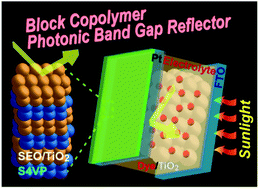Periodic layered inverse micelle multilayers with tunable photonic band gap: fabrication and application in dye-sensitized solar cells†
Abstract
Periodic organic–inorganic multilayer films are constructed by stepwise alternate build-up of UV-stabilized poly(styrene-block-vinylpyridine) block copolymer inverse micelles and poly(styrene-block-ethylene oxide) block copolymer layers containing inorganic moieties at the polar core blocks. The layered block copolymer inverse micelle films show strong reflective color and well-defined photonic stop bands in the entire wavelength region from visible to near IR, which can be fine-tuned by controlling the inner architectures, i.e., the periodic size of the layered structure. The layered block copolymer films are integrated into the back-side of counter electrodes as a light reflection layer and thereby an enhancement ratio of ∼11% in the cell efficiency is achieved, which can be attributed to the increased light harvesting by the sensitized dye molecules. Tailoring the inner structure of the photonic band gap multilayers, the wavelength of reflected light can be adjusted to the wavelength of dye absorption, leading to a noticeable enhancement in photocurrent and power conversion efficiency.


 Please wait while we load your content...
Please wait while we load your content...